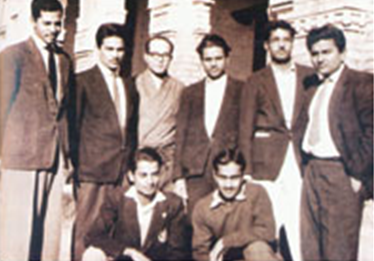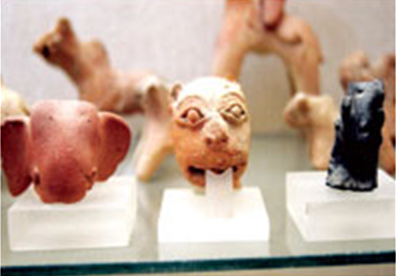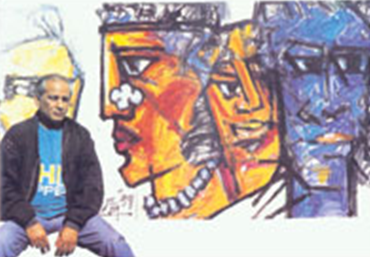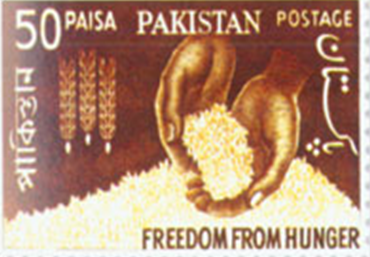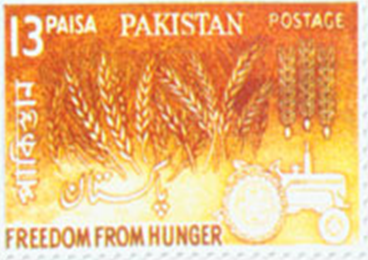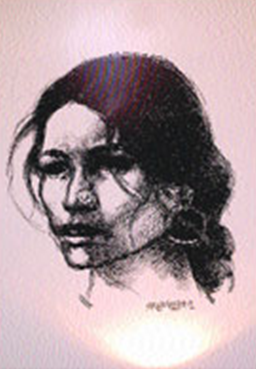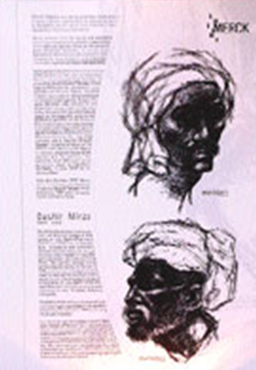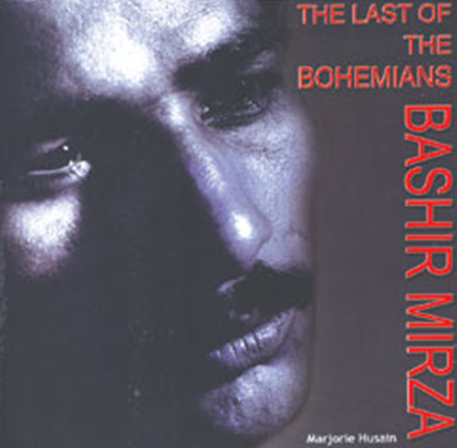Bashir Mirza
This is a collection of articles archived for the excellence of their content. Readers will be able to edit existing articles and post new articles directly |
Contents |
An overview
Bashir Mirza (1941-2000) was a renowned Pakistani painter and sculptor. He was born in Amritsar, India, and moved to Lahore, Pakistan, after the partition of India in 1947. Mirza received his early education in Lahore and later graduated from the National College of Arts (NCA) in 1964.
Mirza's artistic style was influenced by the modern art movements of the 20th century, particularly Abstract Expressionism and Pop Art. He was known for his bold use of color, experimental techniques, and unique approach to portraiture. Mirza's work often featured social and political commentary and reflected his observations of Pakistani society.
In addition to his work as a painter, Mirza was also a prolific sculptor, creating large-scale installations that explored the relationship between art and the environment. He was a founding member of the Lahore Art Circle, an influential group of artists who were instrumental in shaping the modern art scene in Pakistan.
Mirza's work has been exhibited in galleries and museums throughout Pakistan and internationally. He was the recipient of numerous awards, including the Pride of Performance Award from the President of Pakistan in 1989. Bashir Mirza passed away on August 14, 2000, in Lahore, Pakistan, at the age of 59
Bashir Mirza's art
A
January 21, 2007
EXCERPTS: An artist is born
The life and work of artist Bashir Mirza (1941-2000).
Marjorie Husain writes about Bashir Mirza’s first few steps into the world of art.
After completing his primary education, Bashir joined the Muslim Model School. While walking to and from school, he often watched with interest the hoarding painters working on huge cinema billboards and banners.
After passing his matriculation exams in the first division, Bashir was at a loss as to what he should do next. His parents demanded that he start earning some money and knowing of his interest in drawing, suggested he become apprenticed to a signboard painter. Bashir agreed to this and applied for a job. He recalled being taken on a trial basis for the work about which he was initially quite optimistic. Gradually he was given more responsibility, eventually drawing an enormous eight-foot enlargement of a face for a roadside hoarding. As time went on, he became bored, finding the work tedious and the rewards few. He noted with impatience that his employer was reluctant to teach him the tricks of the trade and in sheer frustration he walked out of the job one day.
This was an unhappy time in his life, but it was to change dramatically and forever as the result of an advertisement spotted by chance in a newspaper while sitting on a park bench. Bashir read that applications were invited to apply for admission to the National College of Arts, previously the Mayo School of Arts and Crafts … Bashir was tremendously excited. At last he knew what he wanted to do. Braving the displeasure of his parents, he applied for admission to the college. This proved to be a major turning point in his life.
In 1958, the Mayo School of Arts and Crafts, founded by the British in 1875, began to take a new direction. Professor M.R. Sponenburgh took charge as the principal of the renamed National College of Arts, Lahore, and introduced modern methods in art education in the fields of architecture, design and fine art. He deeply admired the traditional arts of Pakistan and urged students to study their own environment rather than look further afield. He initiated field trips to all regions of the country to enable students to study the local arts and crafts. Many of those students, now senior citizens, are all well established in their respective fields. They look back on that era of the college with a sense of nostalgia.
Professor Sponenburgh was a fine, sensitive man with years of art experience to his credit, and Shakir Ali, as head of the Fine Art Department, ably supported him. Shakir Sahib who was personally committed to the concept of Analytic Cubism, was thoroughly conversant with eastern and western art history, philosophies and aesthetic developments. He was instrumental in establishing modern art in Pakistan, and was an inspiration to his students. It was during his time that some of the country’s finest artists and educationists emerged from the college. Both Sponenburgh and Shakir Ali are remembered as men of integrity and rare quality who, above all, took a sincere interest in and gave warm encouragement to the students in their care.
For Bashir Mirza, the timing was perfect. Putting together a portfolio of drawings for his interview, he dressed up in a shirt and tie and set off for his first meeting with Shakir Ali. His educational qualifications were acceptable and although his English was then non-existent, his drawing skills were strong. During the admission procedure Bashir was asked to draw a traditional mela and he drew the familiar festival of the Urs of Data Ganj Buksh with great élan and vitality. Shakir Ali immediately recognised his potential and sensed the vulnerable being behind the façade. Admission to the college was granted and, with his elder brother’s help, Bashir scraped together the admission fee. Realising his difficulties, Shakir Ali sympathised with him and arranged for Bashir to receive a scholarship. He also found him an evening job with a publisher. Bashir was thrilled to be able to meet many of the time’s literary giants through his job. These included the revered poet Faiz Ahmed Faiz.
Shakir Sahib took a personal interest in Bashir Mirzabecause of his obvious talent and drive, and BM never forgot his mentor’s kindness. Shakir Sahib was his first hero, venerated throughout his life. So, in 1958, Bashir Mirza’s life turned around completely. As an art student, he was for the first time in a congenial atmosphere and was being appreciated for his abilities. He began to live and work with a purpose.
Bashir was among the first batch of students to be admitted to the newly structured National College of Arts, and with him were Mian Salahuddin, Zahoorul Akhlaque, Nayyer Ali Dada, Ahmed Khan and Akhtar Zuberi. Bashir admired all of them for their commitment to work and outstanding talents and they remained his friends. He is remembered by his contemporaries as being particular about his clothes, always neat and totally focused on his work.
The foundation year was spent in studying general subjects and Bashir found the diversity of the work exciting and stimulating. At the end of the first year, the students chose their areas of specialisation and Shakir Ali advised and expected Bashir Mirza to focus on fine art. Though he was loath to displeasure his honoured mentor, the hard times he had undergone had left their mark on his reasoning. He had experienced what poverty could do to people, had seen his own father turn into a bitter, frustrated man who would be quick to lash out his fists, and even at his young age, he knew the despair of those without recourse. Bashir Mirza’s overriding priority was to equip himself to earn a decent living and he opted for graphic design. Though Shakir Ali was initially very disappointed, he saw the boy’s capacity for work and realised whatever discipline Bashir Mirza chose, he would continue to paint.
During his four years of art study, Bashir worked very hard, achieved good results and won the respect of his fellow students and, most important, of Professor Shakir Ali. It became his habit to spend his weekends and holidays painting at the college. He would often be the only person on the campus and would be completely absorbed in his work. Observing this, Shakir Ali paid fees to models from his own pocket to enable Bashir to continue with his work. The first painting Bashir Mirza produced at the NCA, Shakir Ali preserved in his own collection and Bashir took great pride in his fact, mentioning it often.
Recalling those days in 1962, fellow students describe Bashir Mirza’s fourth year display as “very impressive”. He had mounted a campaign focused on an airline for his final examination and in those days, art students not only had to convince the panel of professionals who juried their work of his credibility, but more important, to satisfy Professor Shakir Ali, whose approval was the highest of accolades. With Shakir Sahib there were no coverups, no excuses. He knew each one’s capabilities and expected his students to work sincerely. In return he gave them his genuine interest, guidance and total support.
Graduating from the National College of Arts with distinction, Bashir set off for Karachi to seek fame and fortune. In Lahore he had known poverty and fear, and in later years he seldom visited that city. On the strength of his work he had been offered a job at the Pakistan Security Printing Corporation, Karachi, and he accepted it with alacrity as his first stepping stone to independence. Bashir Mirza was ready to move on with his life.
Excerpted with permission from Bashir Mirza: The Last of the Bohemians By Marjorie Husain Merck Marker (Pvt) Ltd Available with Liberty Books Park Towers, Clifton, Karachi Tel: 021-5832525 (ext: 111) www.libertybooks.com 222pp. Rs1,000
Marjorie Husain, an authority on the art history of Pakistan, is an art critic and curator of a number of exhibitions.
Bashir Mirza II
A belated tribute
By Anis Zuberi
Bashir Mirza was an endearing person. If he left behind a large body of inimitable paintings and sketches, he also left behind a wide circle of friends and admirers. He had seen the seamy side of life and had also basked in his celebrity status, which he achieved after he got well deserved ovation for his art. BM, as he was called by one and all, had his mood swings, and as his friend and biographer, the noted art critic Marjorie Husain writes in Bashir Mirza: The Last of the Bohemians he slipped into sadness when he thought of the struggle he and his family members had to face when they moved from Amritsar to Lahore, but the next moment when he would drift from past into present where the kudos that he won, lifted his spirit. But what remained unchanged was the excellence of his work. His strong lines and compositions could only be matched by his sincerity of purpose.
Marjorie Husain, who has projected Pakistani art more consistently and dedicatedly than most of our art writers, was seen autographing copies of her latest book at the launch of the well written and profusely illustrated coffee table book in Karachi. The launch of the volume, sponsored by Merck Marker, was accompanied by the launch of the pharmaceutical company’s calendar for 2007 featuring BM’s famous pen-and-ink sketches in the series Portrait of Pakistani (1967), which ranks among the finest works produced in this genre since independence.
This is the fifth year since the company first produced its calendar. In all these years the theme of the give-aways has been the country and its art. The first calendar featured Gulji’s paintings, the second showed rich Balochi embroidery patterns as painted by the students of Indus Valley School of Art and Architecture, while the third displayed specimens of modern and ethnic Pakistani fashion. Last year’s calendar featured the landscapes of different regions of the country through paintings. These and 18 other paintings of six artists were also taken to Frankfurt for an exhibition in July by Merck.
At the book and calendar launch last week at the newly opened Acropolis Halls in Clifton, Karachi, there were a large number of people from different fields. There were diplomats, business persons, socialites, art enthusiasts, artists and media persons. While you could see a few were there only to socialise, most guests feasted their eyes on the Portrait of Pakistan series displayed along with their reduced reproductions for the calendar. But in the other hall, what attracted the viewers the most were 22 colourful BM paintings from the collection of artist cum art collector Wahab Jaffer. Vying for space was the vintage BM painting loaned by Minocher Marker.
It is heartening to note that since the sixties, a section of the private sector has been supporting fine and performing arts in this country. It dates back to the time when UBL, under Agha Hasan Abdi, published Sadequain’s paintings based on the verse of Mirza Ghalib in a widely distributed diary. That gave the artist wider recognition among the business class, not to speak of the financial benefits that the ace artist got when he was on the border of penury. About the same time the late Mansoor Bokhari, who was heading the corporate affairs department of Pakistan Tobacco Company, produced a 45 RPM record featuring excellent recordings of a ghazal by Farida Khanum and Mehdi Hasan on the two sides of the disc. More recently in the nineties Citibank’s consumer division, under Nadeem Hussain, brought out two CDs on Ghalib, one of which comprised 12 previously recorded ghazals by the likes of Begum Akhtar and Mohammed Rafi, and the second CD had specially recorded numbers by this country’s leading ghazal singers. Pakistan Refinery has in this decade sponsored S.M. Shahid’s books on music and art. However, the number of such sponsors is small and needs to increase manifold.
Bashir Mirza III
Tribute to a great modernist
By Murtaza Razvi
Few artists are good with words, for their vocabulary in the main comprises visual imagery. Fewer still, who insist on explaining their own art, make sense. The rest are incorrigible philistines trying to mix the verbal and visual media; chances are they are truly good at neither, and sooner or later it shows. Just as an original painter delves into his muse unawares, and unbothered about the critic's choice of words to analyse his art, an original writer is overwhelmed by the presence of what he or she beholds; the passion that an impromptu descriptive narration brings to the writing of a good critic is no less a piece of art.
Perhaps this is why it is always intriguing to see how two people who are good at what they have been doing for a long time fare when they come together to produce a new work of art. Descriptive narration in words is no less than visual narration when the two combine; the inimitable Bashir Mirza's magnum opus by Marjorie Husain is reflective of this spirit, a must-have for the initiated enthusiast of contemporary Pakistani art. For the uninitiated it presents a great introduction to the captivating late BM, and modern painting as his chosen genre.
Collating such a diverse material and viewpoints as Husain had to go through in the course of her research for the book is no less interesting a story behind the main story, of which BM emerges as no less than a classical Greek hero with conflicting and endearing personality traits. In the absence of an authoritative databank on the lives and works of modern Pakistani artists, the task demanded studying most previous documentation that various individuals had taken pains to put together on their own; yet, the story could only be told fully by conducting interviews with friends, acquaintances and family members of the late painter, entrepreneur, adman and, above all, a very passionate human being. Husain has also had to draw heavily on personal recollections spanning 35years.
Putting in a logical and chronological order the unruly and unbridled as well as somewhat disciplined life, that BM's vocations from time to time forced him into, was no less a challenge.
The book starts at the birth of the artist, as did his trials and tribulations, the interplay and rush-on of good and bad times which were to define BM and his work for a lifetime. Every point of the painter's life from his formative years - rising from humble beginnings - has been documented with no details being missed. Following through the perpetual cycle of the highs and lows which consumed BM and made his work shine by a tragic contrast and then making sense of all this turbulence in the great painter's life is the real feat of this book.
Written with a rare passion that one reserves for the best of one's friends, here are documented each and every watershed in the life of the modern painter, his art school days at the NCA, his coming and settling down in Karachi, finding love and then losing it, the gallery business, brush with printmaking and advertising, foreign travels and return home, and decade by decade, intimate account of the goings on in the painter's life and surroundings, coupled with detailed descriptive narration of his changing style and varying thematic obsessions.
Original photographs taken from the albums of family members and friends and a very representative reproduction of BM's entire oeuvre are what complete the book. Truly a befitting tribute to the man and painter Bashir Mirza was. The book has to be seen, and seen over and over again, even if just for the visual delight it offers; it has to be read and kept on the shelf for any ready reference that you may require. But most of all, it has to be bought to feel good as a proud possessor of a well researched piece of art history. Indeed, a rare commodity in this country.
